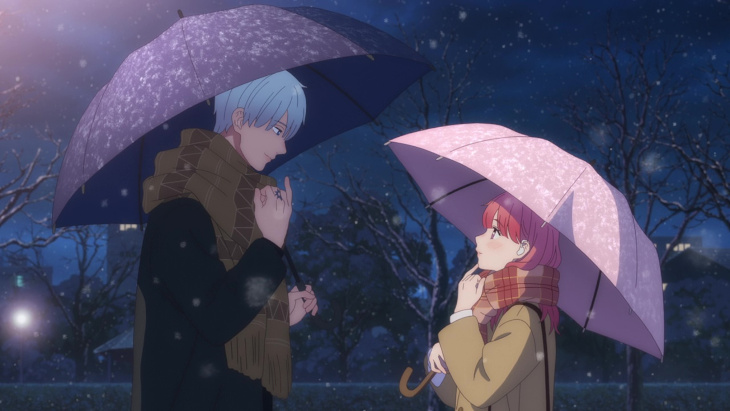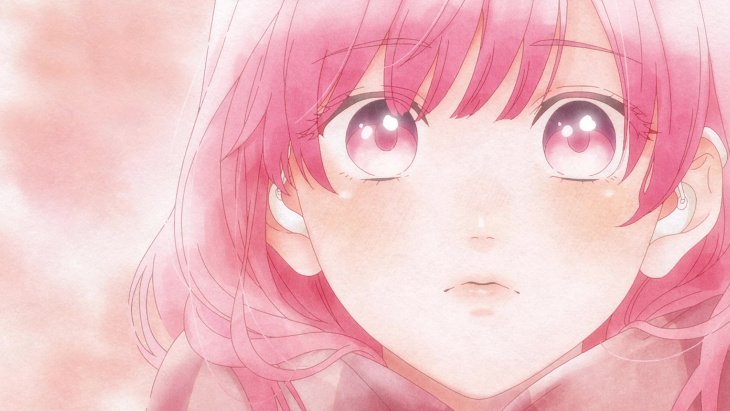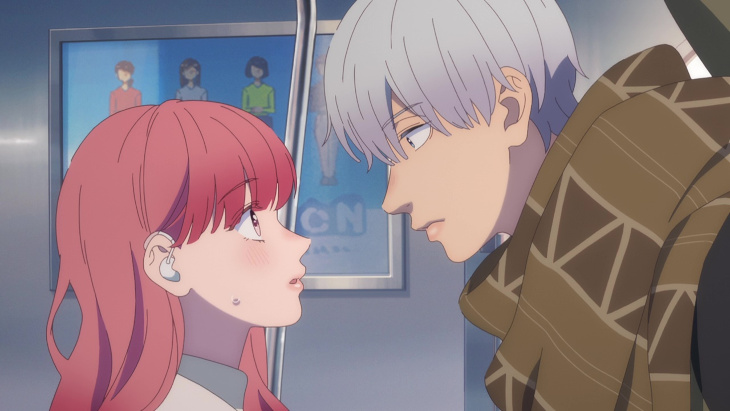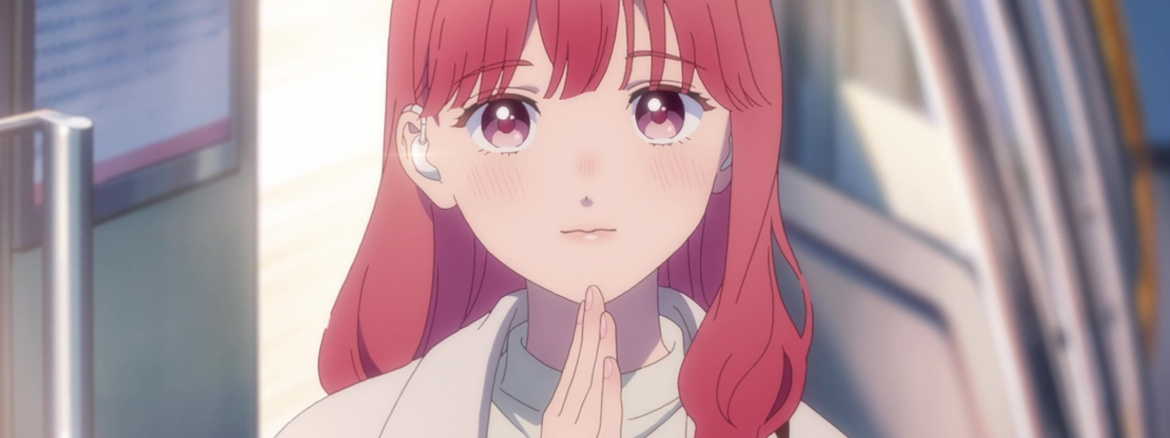
“Is love like the snow? Does it arrive silently, with no fanfare? Will it fall from the cloudy skies above and color the world in its hue?”
Sometimes a show makes a strong impression with you right from the start. Those types of series often stick with you for better or worse. It will be a long time before I forget the sense that I was in for something special the moment Frieren’s OP started up, but likewise, I doubt I’ll forget the way Skeleton Knight decided to kick off its first episode either. Fortunately, A Sign of Affection began in a simple but appropriately affecting way, a stripped down but poetic question of what it feels like to be in love, all while a quiet tinnitus tone drowned out the background sound. Given the subject matter of the show, this is a spectacular way to sell the viewer on an emotional dilemma that our main character faces, while using the audio to indicate why this is more complicated for her. I’m not saying this episode is perfect. There are some quirks of the art and direction that nag at me, but it’s been a while since I saw a good straightforward romance that hit these particular notes… I typed that and then found myself waffling on the fact that I’d unwittingly used a musical phrase to describe this show, and I don’t know how to feel about that. To anyone looking for a delightful shojo romance series, which approaches the topic from an angle rarely seen in anime, but maintains a strong sense of pleasant charm, A Sign of Affection is easily a must watch.

The show follows Yuki, a young college student who has been deaf since birth. One day on the train home from class, she encounters a fellow student who, after helping her give directions to a fellow passenger, strikes up a brief conversation with her, inquiring about her condition. Yuki finds herself thrown off by the stranger’s forwardness, as instead of moving away because of the awkwardness of the conversation, he instead moves in close and enunciates deliberately so that she can make out his lip movements more clearly. She recognizes this stranger, Itsuomi, as an acquaintance of her friend, Rin, and uses the opportunity to encounter him again. The pairing of these two forms an awkward balance. The show acknowledges that Itsuomi’s tendency to interact physically can be off-putting or uncomfortable, but it enables him to communicate more easily with Yuki. The combination leads to ridiculously cute scenes, the likes of which only shojo can deliver. If I did have a complaint, the connection between the two felt mildly rushed in this episode. In lesser hands, these moments have the potential to come across as cloying, and with this brisk pace, I wouldn’t be surprised if it fell on the “overly saccharine” side of the fence for some viewers. However, I found it perfectly delightful in a way that feels puzzlingly like both a breath of fresh air and a nostalgic throwback.

The studio behind this show is Ajia-Do Animation Works, a name that also evokes the absurd blend of tones I just referenced. Ajia-Do is a studio that has been around since the late 70’s, but has a limited and oddly eclectic output. Their claims to fame among western viewers would mainly be the peculiar throwback The Real Ghostbusters, and the more recent isekai series Ascendance of a Bookworm. I mainly know the studio for their work on How Not to Summon a Demon Lord and Kemono Jihen. Kemono Jihen proved to me that the studio could produce some striking visuals, and it’s nice to see that capability reflected in this show as well, though I find the shading around the characters’ mouths to be oddly distracting. I think it’s due to it being applied more heavily on the male characters, even though it’s usually the inverse. I’m sure I’ll get used to it eventually. The airbrushed pastel styling of the visuals is mildly reminiscent of Honey & Clover, but remains distinctive in its own way and at least the mouths aren’t as wide. The OP is pleasant, if not altogether striking. The opening chords are simple and strikingly familiar, but I can’t place my finger on why, so that’s likely to nag me for the rest of the show. Likewise, the ED is nice, but not too striking, outside of the rarely seen approach of incorporating previews of the next episode into it.
Before I wrap up, a few Notes and Nitpicks:
- Seriously, why does that OP sound so familiar? I considered the possibility it reminded me of Sitting, Waiting, Wishing by Jack Johnson. This is the second time I’ve referenced Jack Johnson when discussing anime openings. I wonder if he’s simply the artist I most associate with acoustic guitar strumming? I honestly don’t know any other songs by him. Yeah, this is going to occupy a place in my brain for the rest of the season.
- I watched a little bit of the first episode of Ascendance of a Bookworm, but ended up not finishing it. I think I was unimpressed with the visuals and experiencing some isekai fatigue. I’d try and pick it up again, but it’s become a moderately robust series, with a fourth season coming soon, so it would be a bit of a time investment.
- I watched the first episode of How Not to Summon a Demon Lord back when it aired, but it looks like I couldn’t bring myself to review it.
- I’m about to say something a little embarrassing, but in my defense, I only started using the English title when drafting this review. I was mostly thinking of this show as Yubisaki to Renren, so… I only just noticed the double-meaning of the title.
A Sign of Affection was just a delightful time. It’s going on my to-watch list for sure. If you want that feeling of warm fuzziness that only shojo can deliver, A Sign of Affection seems primed to deliver regularly on that front.




Add comment